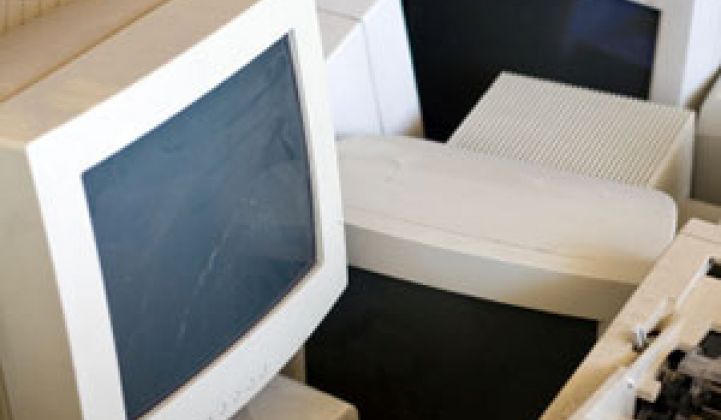The PC is dead.
I heard that every few weeks for nine years when I ran the hardware division at News.com, a technology news site. First, Net PCs were going to kill them. Then, the sub-$1,000 PC was going to eviscerate industry profits. Game consoles would become the gateway the Internet. Then it was Internet appliances, like Audrey. Then smart phones.
The funniest part is that these comments didn't just come from random Internet cranks. They also came from my boss.
PC shipments came to 135.5 million units in 2001, a year that some called the beginning of the end for the PC market, according to Richard Shim of IDC. In 2008, when demand dropped off, shipments came to 295 million, or more than double. Not everyone made money in the last seven years, but Google became a household word through PC searches, Intel and Microsoft expanded their reach, and Hewlett-Packard went from struggling with a strategy devised by Carly Fiorina to sell services and software to a rebirth by re-emphasizing consumer PCs.
To be honest, being like the PC industry would be one of the best things ever happen to the solar industry.
So, is it possible?
At first glance, it's a stretch because PCs and solar panels remain very different creatures. The entire PC market is based around steady price declines, rapid turnover, improving technology and expanding capabil ities, thanks to Moore's Law. It's the industrial equivalent of the triple Salchow.
The same doesn't exist in solar. No one replaces their solar panels three years after they buy them because the new ones are pink. The power-efficiency ratings creep up only a little bit every year so you're not tempted to upgrade either.
It's like a high school math teacher and a gag Einstein tie: You buy it once and you're good for life.
With this outlook, steady cost reductions become the only determinant in solar.
Luckily, ways to escape from this trap have begun to emerge. First, creative ways to really drop prices have begun to crop up. Telio Solar, for example, has figured out how to produce copper indium gallium (CIGS) solar cells on equipment lines largely adopted from the LCD TV industry (see Green Light post). This sort of equipment adaptation has allowed it to build a pilot plant for $3 million, extremely low in CIGS. Plastic – one of the cheapest materials around – is also getting mixed into solar. Ascent Solar Technologies says it can make CIGS on polymer substrates while Cool Earth Solar has a Mylar concentrator (see Ascent Solar Makes CIGS on Plastic and Can Concentrators Stay Fresh With Plastic Wrap?). These are technologies that exist in the name of cost reduction, but the savings (and more like them) are potentially sizeable enough to goose a significant boost in demand.
Second, you're seeing the first stabs at improving the customer experience, the real driver of the PC market. It started last year with Sungevity, which came up with an application that let consumers get a solar estimate at home. No more making an appointment with a contractor that will climb around on your roof for a few hours. Instead, you go online, and a woman that looks like Lindsay Wagner guides you through a video game involving your home.
This year, another phase of this process began with the solar appliances. Chromasun, founded by Ausra co-founder Peter Le Lievre, makes a solar-powered air conditioner (see Ausra Co-Founder Returns With Solar Air Conditioner). Colorado's BrightPhase Energy has a device for producing light, electricity and hot water. Entech has heat and electricity. These devices use a lot of the same basic components that regular solar systems do but they are designed with specific customers and applications in mind. If they can come up the magically delicious formula for a rooftop device that appeals to lots of buyers, they can sell devices and maintain margins.
Granted, this is really about innovation around the frame of the module, not the solar cell itself. Thus, solar purists will probably sneer. But the same thing happened in computers: Transistors became anonymous components in chips, and chips mostly became faceless devices inside boxes from Dell. Module scientists, be forewarned – you're being pushed to the back of the class picture.
We will likely see a third element of this evolution come next year with solar fabs and more sophisticated contract manufacturers. Fabs, short for fabrication facilities, changed the IT industry by allowing chip makers to outsource manufacturing so they could concentrate on design and sales. It was an outlandish idea when Morris Chang first suggested it, but his company TSMC is now one of the biggest semiconductor companies in the world.
Solar fabs right now don't exist, but imagine if they did, Marco DeMiroz, a partner at Trinity Ventures, asked me. Professors at UC Berkeley or Stanford could incubate small companies and farm out prototyping and manufacturing to a mega-fab. No more worrying about raising $50 million to build a factory or buy tools: a solar startup could be kicked off for a few million or less.
Solar fabs could differentiate themselves: Some could become experts in crystalline silicon while others could specialize in cadmium telluride and III-V devices. Venture capitalists could recruit execs out of Novellus, Applied Materials and Intel to run these companies: It's a movie they'd all be familiar with.
Fabs and better contract manufacturers in turn would unlock the true potential of Asia. Right now, it's viewed as a low cost destination. You know the image. "Last week, we made stuffed animals and ladies' leg shavers. Now we do inverters, soldering guns and counterfeit 555 cigarettes."
With a proliferation of fabs, Chinese and Korean would define the technological cutting edge. This isn't all that farfetched. It's happened before.
Believe me. The solar market isn't dead yet.



